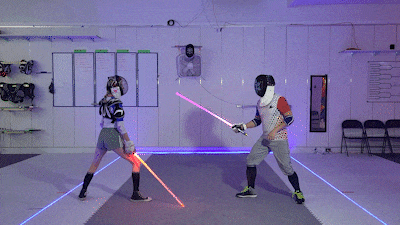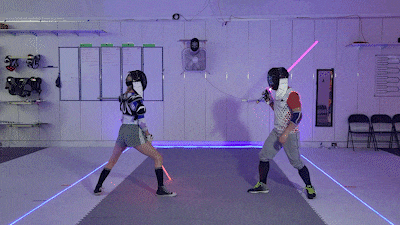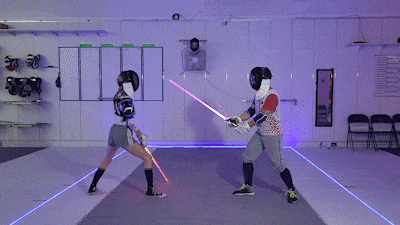As a “first touch” sport, speed is obviously a critical factor to victory in Lightspeed Saber. However, speed is often tied to excessive force or power— erroneously— which diminishes our sport, and can lead to penalties or disqualification for individual competitors. Here’s how to fence competitively and safely.
WHAT IS EXCESSIVE FORCE/POWER?
Excessive force is the inaccurate acceleration of an attack.
Because Lightspeed Saber contacts (aka “hits”) are judged based on the slightest touch, the only acceleration necessary for a successful attack is that which delivers it to a target’s surface and no further. Any acceleration beyond this point may be charitably considered a misjudgment of the target area’s distance and/or place in space.
The inaccurately accelerated attack goes significantly past the target’s surface (the glove).
HOW DO YOU PREVENT EXCESSIVE FORCE?
There are two main methods for attacking safely without sacrificing efficacy: the percussive cut and the collapsing cut.
PERCUSSIVE CUT
In a percussive cut, the weapon accelerates to the target then rapidly retracts just as it reaches the surface of the target, returning more or less to its original position when the attack was initiated. This can be thought of as a “tap” or a wounding or burning cut if the weapon was a real.
To perform a percussive cut:
Accelerate your attack up to to the surface of the target (preferrably an armored one).
Quickly retract your arm or wrist and withdraw the weapon just as it is making contact.
DO NOT leave the weapon extended after the contact.
You’ll know you did it well if:
Your blade contacted the surface exactly ONCE before retraction.
You generated a clear and distinct sound, loud enough for yourself, your opponent, and your referees to hear.
And your blade did not bounce on, press or bend into, or glance off the target.
A set of well-executed percussive attacks.
More well-executed percussive attacks, including a chambered variation.
Unsafe percussive attack. Leaving the weapon at extension after a percussive cut is called “holding” and is unsafe and illegal.
Poor percussive attack. If your attack exhibits this kind of bouncing or vibration, then you have misjudged your acceleration.
Poor percussive attack. If your attack exhibits this kind of glancing off, pressing, or bending into the target, then you have misjudged your acceleration.
COLLAPSING CUT
In a collapsing cut, the blade continues to move in its original arc even after making contact with the surface of the target area, but with a visually distinct relaxation or collapsing of the arms as the contact is being made.
To perform a collapsing cut:
Accelerate your attack.
At the apex of the attack (when the attack reaches its maximum range and usually where your target lies) relax or collapse your arm at the elbow and/or wrist.
Momentum will usually carry the weapon through the remainder of its path.
You’ll know you did it well if, in order of importance:
Your arm is bent at the end of the action.
The attack only contacted the opponent once.
The blade tip stayed in the lead of the hand as opposed to its side or behind.
Good collapsing cut. Only touches once, the arm finishes collapsed, and the blade tip finishes forward.
Noncollapsing cut. Attack strikes multiple targets. Arm is rigid the whole way through and the blade tip finishes to the side, indicating a large acceleration arc.
Another noncollapsing cut. Note the way the blade tip “skips” along the opponent’s body.
COLLAPSE vs NON-COLLAPSE
Note how the arm collapses after reaching the apex of the attack
The continuously accelerating attack cuts a large angle, 180° or more (pay attention to the travel of the blade tip). This is excessive and unnecessary.
Continuous acceleration offers little to no speed advantage, but can lead to joint damage and self-injury. The decelerating attacks are fast, safe(r), and effective.




